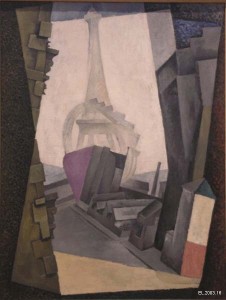The Davis Museum is closed for Wellesley College’s winter break. Please join us at our spring opening celebration on February 5, 2026, at 4 pm.
The Eiffel Tower

While Diego Rivera is immortalized in history as one of the pioneers of the revolutionary Mexican mural movement of the twentieth century, his foray into the avant-garde in Paris from 1913 to 1917 yielded its own radical art. Befriending artists such as Pablo Picasso and Georges Braque, Rivera rejected the aesthetic traditions of the Paris Salon and experimented with Cubism, a radical art movement that eschewed the Académie des Beaux-Arts’ conventional Renaissance perspective for an abstracted outlook on the world. In The Eiffel Tower, Rivera depicted disjointed buildings from multiple vantage points that collapse and crumble around the ghostly off-kilter Eiffel Tower and Great Wheel. Desolate factories that tilt at precarious angles and a skewed band of black paint, resembling a window frame, leave the viewer with an unstable and perilous point of view. Instead of celebrating the Eiffel Tower as a symbol of France’s flourishing modernity and new liberal democracy, Rivera emphasized the insecurity and disorientation of modern fin-de-siècle society. The turbulent and haphazard cityscape conveys the emotional ambivalence with which many received technological innovation, as well as the social and psychological repercussions of a transitioning culture.
Rivera’s Cubist style created a compelling perspective through which the Parisian cityscape could be portrayed not only because it captured the flux of modernity, but because the style challenged conventional values. Cubism disengaged itself from established artistic precedents and marked the birth of modern art. Thus Cubism paralleled society’s modernization in its shift away from tradition, and ultimately allowed Rivera to paint a potent picture of early twentieth-century Paris.
An expatriate in Paris for several years while on a government-sponsored art scholarship, Rivera never renounced his Mexican nationality, incorporating mementos of his heritage into many of his paintings. In The Eiffel Tower, Rivera expressed his national identity with the green, white, and red colors of the Mexican flag at the lower right of the composition. His exploration of Paris’ volatile social climate and its impact on the human condition portend central themes in his large public murals in Mexico City, and intimate Rivera’s development as a politically influential artist.
This work is currently on view in the Dorothy Johnston Towne Gallery on the second floor of the museum.
Michaela Haffner ’14
Curatorial Intern, Summer 2012